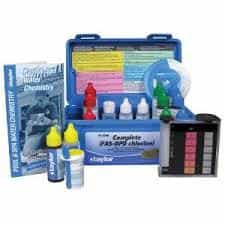If you manage or operate a public swimming pool you most likely spend a lot of your time at your facility. Some people in this position think they know their pool so well that occasionally they fall to the temptation of skipping testing their pool water. Or if they are in a rush, they may perform fewer tests and take other shortcuts. Allegheny Pool Services Co. urges you not to make these mistakes. Missed tests and shortcuts result in long hours solving preventable problems. Testing your water consistently and interpreting your results correctly will help you keep your water balanced and your job easier.
The first step to consistently testing your water involves meeting your local code requirements. In Allegheny County, managers of outdoor public pools must monitor their pool’s pH and free chlorine before opening the pool and every two hours during the time the pool is open. Indoor facilities require monitoring these levels every six hours the pool is open. For both indoor and outdoor pools larger than 100,000 gallons a test must be performed for both the deep and shallow end.
The second step to regular testing requires setting times to perform the tasks. Codes provide a minimum requirement. For outdoor pools especially, it may be beneficial to test the water more frequently. In addition to testing water pH and chlorine level, you should also set times to test other water balance factors such as, total alkalinity, calcium hardness, and cyanuric acid levels.
The third step in the process calls for you to decide on a method of testing. Below I provide you with a brief general summary of three testing methods. When using any of the methods describes you should check to make sure the test kit you are using is approved by your local health department. You should also follow the test kit manufacturer’s specific instructions.
Colormetric: Colormetric testing is the most common form of a water test. Manufactures have designed colormetric tests to measure the amount of chlorine, bromine in the water. This type of test is also used to determine pH. The test involves adding reagents (testing chemicals) to a water sample. The reagents react with the levels in the sample and cause a change in color. The person testing the water compares the resulting color to a color comparator to determine the results.
Titration: Titration testing uses reagents that you drop into a collected water sample. The reagents cause a change in color. In this test the shade of the color is not a deciding variable. Instead the person testing the water adds a second chemical by the drop until a disappearance of color or change in color is reached. Each added corresponds to a specific level of the water factor being tested. In the past most people only used the titration method to determine a pool’s calcium hardness and total alkalinity. There has been an increasing use of the titration method to test free and combined chlorine through a FAS-DPD method. Allegheny Pool Services Co. suggests this method for chlorine testing. FAS-DPD testing allows for more specific and precise chlorine readings.
Turbidity: Turbidity testing is typically employed for measuring cyanuric acid (stabilizer). In this test a reagent reacts with the chemical being tested to create a turbidity or cloudiness. The relative interpretation of the sample’s turbidity compared to a manufacturer's description is used to arrive at a reading.
I hope you found this explanation of water testing useful. Allegheny Pool Services Co. aims to assist you. If you have any questions regarding the topics in this article or would like to discuss any other pool issues please contact us. We are available to provide you with test kits and testing training. You can also find more information at our homepage.
Thanks for Reading,
Tim Johnson

